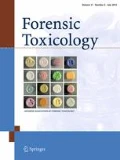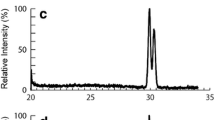Abstract
Inhibitory effects of Δ9-tetrahydrocannabinol (Δ9-THC), cannabidiol (CBD), and cannabinol (CBN) on the catalytic activities of human recombinant cytochrome P450 (CYP) 2A6 and CYP2B6 were investigated. Δ9-THC, CBD, and CBN noncompetitively inhibited coumarin 7-hydroxylase activity of recombinant CYP2A6 with the apparent K i values of 28.9, 55.0, and 39.8 μM, respectively. On the other hand, Δ9-THC, CBD, and CBN inhibited 7-benzoxyresorufin O-debenzylase activity of recombinant CYP2B6 in a mixed fashion with the K i values of 2.81, 0.694, and 2.55 μM, respectively. Because the inhibition of CYP2B6 by CBD was the most potent, investigation was conducted to determine which moiety of the CBD structure was responsible for the inhibition. Olivetol and d-limonene, the partial structure of CBD, inhibited the CYP2B6 activity to some extent. Inhibitory effects of CBD-2′-monomethyl ether and CBD-2′,6′-dimethyl ether attenuated with the number of methylations on the phenolic hydroxyl groups in the resorcinol moiety of CBD. Cannabidivarin, a CBD analogue having a propyl side chain, inhibited the CYP2B6 activity less potently than CBD possessing a pentyl side chain. Therefore, both structures of pentylresorcinol and terpene moieties of CBD were suggested to play important roles in the CYP2B6 inhibition. Δ9-THC, CBD, and CBN showed metabolism-dependent inhibition for CYP2A6 but not for CYP2B6. Furthermore, Δ9-THC and CBN were characterized as mechanism-based inhibitors for CYP2A6. The k inact and K I values of Δ9-THC were 0.0169 min−1 and 0.862 μM, respectively; the k inact and K I values of CBN were 0.00909 min−1 and 1.01 μM, respectively. These results indicated that Δ9-THC, CBD, and CBN showed differential inhibition against CYP2A6 and CYP2B6.




Similar content being viewed by others
References
Kudo K, Ishida T, Hikiji W, Usumoto Y, Umehara T, Nagamatsu K, Tsuji A, Ikeda N (2010) Pattern of poisoning in Japan: selection of drugs and poisons for systematic toxicological analysis. Forensic Toxicol 28:25–32
Uchiyama N, Kikura-Hanajiri R, Kawahara N, Goda Y (2009) Identification of a cannabimimetic indole as a designer drug in a herbal product. Forensic Toxicol 27:61–66
Uchiyama N, Kawamura M, Kikura-Hanajiri R, Goda Y (2011) Identification and quantitation of two cannabimimetic phenylacetylindoles JWH-251 and JWH-250, and four cannabimimetic naphthoylindoles JWH-081, JWH-015, JWH-200, and JWH-073 as designer drugs in illegal products. Forensic Toxicol 29:25–37
Hall W, Degenhardt L (2009) Adverse health effects of non-medical cannabis use. Lancet 374:1383–1391
Van Vunakis H, Tashkin DP, Simmons M, Clark VA (1988) Decreased serum cotinine levels in smokers of both tobacco and marijuana as compared with smokers of tobacco only. Pharmacol Biochem Behav 30:895–898
Nakajima M, Yamamoto T, Nunoya K, Yokoi T, Nagashima K, Inoue K, Funae Y, Shimada N, Kamataki T, Kuroiwa Y (1996) Role of human cytochrome P4502A6 in C-oxidation of nicotine. Drug Metab Dispos 24:1212–1217
Yamazaki H, Inoue K, Hashimoto M, Shimada T (1999) Roles of CYP2A6 and CYP2B6 in nicotine C-oxidation by human liver microsomes. Arch Toxicol 73:65–70
Yamanaka H, Nakajima M, Fukami T, Sakai H, Nakamura A, Katoh M, Takamiya M, Aoki Y, Yokoi T (2005) CYP2A6 and CYP2B6 are involved in nornicotine formation from nicotine in humans: interindividual differences in these contributions. Drug Metab Dispos 33:1811–1818
Di YM, Chow VD, Yang LP, Zhou SF (2009) Structure, function, regulation and polymorphism of human cytochrome P450 2A6. Curr Drug Metab 10:754–780
Mo SL, Liu YH, Duan W, Wei MQ, Kanwar JR, Zhou SF (2009) Substrate specificity, regulation, and polymorphism of human cytochrome P450 2B6. Curr Drug Metab 10:730–753
Ogburn ET, Jones DR, Masters AR, Xu C, Guo Y, Desta Z (2010) Efavirenz primary and secondary metabolism in vitro and in vivo: identification of novel metabolic pathways and cytochrome P450 2A6 as the principal catalyst of efavirenz 7-hydroxylation. Drug Metab Dispos 38:1218–1229
Abass K, Reponen P, Mattila S, Pelkonen O (2011) Metabolism of α-thujone in human hepatic preparations in vitro. Xenobiotica 41:101–111
Code EL, Crespi CL, Penman BW, Gonzalez FJ, Chang TK, Waxman DJ (1997) Human cytochrome P4502B6: interindividual hepatic expression, substrate specificity, and role in procarcinogen activation. Drug Metab Dispos 25:985–993
ElSohly MA, Slade D (2005) Chemical constituents of marijuana: the complex mixture of natural cannabinoids. Life Sci 78:539–548
Huestis MA (2005) Pharmacokinetics and metabolism of the plant cannabinoids, Δ9-tetrahydrocannabinol, cannabidiol and cannabinol. In: Pertwee RG (ed) Cannabinoids. Handbook of experimental pharmacology, vol 168. Springer, Berlin, pp 657–690
Watanabe K, Yamaori S, Funahashi T, Kimura T, Yamamoto I (2006) 8-Hydroxycannabinol: a new metabolite of cannabinol formed by human hepatic microsomes. Forensic Toxicol 24:80–82
Watanabe K, Yamaori S, Funahashi T, Kimura T, Yamamoto I (2007) Cytochrome P450 enzymes involved in the metabolism of tetrahydrocannabinols and cannabinol by human hepatic microsomes. Life Sci 80:1415–1419
Watanabe K, Fujinami M, Yamaori S, Yamamoto I (2011) Possible involvement of Cyp3a enzymes in the metabolism of tetrahydrocannabinols by mouse brain microsomes. Forensic Toxicol 29:56–60
Bornheim LM, Correia MA (1991) Purification and characterization of the major hepatic cannabinoid hydroxylase in the mouse: a possible member of the cytochrome P-450IIC subfamily. Mol Pharmacol 40:228–234
Bornheim LM, Lasker JM, Raucy JL (1992) Human hepatic microsomal metabolism of Δ1-tetrahydrocannabinol. Drug Metab Dispos 20:241–246
Watanabe K, Matsunaga T, Yamamoto I, Funae Y, Yoshimura H (1995) Involvement of CYP2C in the metabolism of cannabinoids by human hepatic microsomes from an old woman. Biol Pharm Bull 18:1138–1141
Fernandes M, Warning N, Christ W, Hill R (1973) Interactions of several cannabinoids with the hepatic drug metabolizing system. Biochem Pharmacol 22:2981–2987
Benowitz NL, Nguyen TL, Jones RT, Herning RI, Bachman J (1980) Metabolic and psychophysiologic studies of cannabidiol–hexobarbital interaction. Clin Pharmacol Ther 28:115–120
Jaeger W, Benet LZ, Bornheim LM (1996) Inhibition of cyclosporine and tetrahydrocannabinol metabolism by cannabidiol in mouse and human microsomes. Xenobiotica 26:275–284
Yamaori S, Kushihara M, Yamamoto I, Watanabe K (2010) Characterization of major phytocannabinoids, cannabidiol and cannabinol, as isoform-selective and potent inhibitors of human CYP1 enzymes. Biochem Pharmacol 79:1691–1698
Yamaori S, Ebisawa J, Okushima Y, Yamamoto I, Watanabe K (2011) Potent inhibition of human cytochrome P450 3A isoforms by cannabidiol: role of phenolic hydroxyl groups in the resorcinol moiety. Life Sci. doi:10.1016/j.lfs.2011.02.017
Aramaki H, Tomiyasu N, Yoshimura H, Tsukamoto H (1968) Forensic chemical study on marihuana. I. A detection method of the principal constituents by thin-layer and gas chromatographies. Chem Pharm Bull 16:822–826
Gohda H, Narimatsu S, Yamamoto I, Yoshimura H (1990) In vivo and in vitro metabolism of cannabidiol monomethyl ether and cannabidiol dimethyl ether in the guinea pig: on the formation mechanism of cannabielsoin-type metabolite from cannabidiol. Chem Pharm Bull 38:1697–1701
Watanabe K, Motoya E, Matsuzawa N, Funahashi T, Kimura T, Matsunaga T, Arizono K, Yamamoto I (2005) Marijuana extracts possess the effects like the endocrine disrupting chemicals. Toxicology 206:471–478
Talakad JC, Kumar S, Halpert JR (2009) Decreased susceptibility of the cytochrome P450 2B6 variant K262R to inhibition by several clinically important drugs. Drug Metab Dispos 37:644–650
Stiborová M, Bořek-Dohalská L, Hodek P, Mráz J, Frei E (2002) New selective inhibitors of cytochromes P450 2B and their application to antimutagenesis of tamoxifen. Arch Biochem Biophys 403:41–49
Rae JM, Soukhova NV, Flockhart DA, Desta Z (2002) Triethylenethiophosphoramide is a specific inhibitor of cytochrome P450 2B6: implications for cyclophosphamide metabolism. Drug Metab Dispos 30:525–530
von Weymarn LB, Brown KM, Murphy SE (2006) Inactivation of CYP2A6 and CYP2A13 during nicotine metabolism. J Pharmacol Exp Ther 316:295–303
Siu EC, Tyndale RF (2008) Selegiline is a mechanism-based inactivator of CYP2A6 inhibiting nicotine metabolism in humans and mice. J Pharmacol Exp Ther 324:992–999
Yoo HH, Lee MW, Kim YC, Yun CH, Kim DH (2007) Mechanism-based inactivation of cytochrome P450 2A6 by decursinol angelate isolated from Angelica gigas. Drug Metab Dispos 35:1759–1765
Koenigs LL, Peter RM, Thompson SJ, Rettie AE, Trager WF (1997) Mechanism-based inactivation of human liver cytochrome P450 2A6 by 8-methoxypsoralen. Drug Metab Dispos 25:1407–1415
Khojasteh-Bakht SC, Koenigs LL, Peter RM, Trager WF, Nelson SD (1998) (R)-(+)-Menthofuran is a potent, mechanism-based inactivator of human liver cytochrome P450 2A6. Drug Metab Dispos 26:701–704
Yamanaka H, Nakajima M, Nishimura K, Yoshida R, Fukami T, Katoh M, Yokoi T (2004) Metabolic profile of nicotine in subjects whose CYP2A6 gene is deleted. Eur J Pharm Sci 22:419–425
Acknowledgments
This work was supported in part by a Grant-in-Aid for Scientific Research (C) and the ‘Academic Frontier’ Project for Private Universities (2005–2009) from the Ministry of Education, Culture, Sports, Science, and Technology of Japan. The authors thank Dr. Yukihiro Shoyama (Faculty of Pharmaceutical Sciences, Nagasaki International University, Sasebo, Japan) for generously providing CBDV.
Author information
Authors and Affiliations
Corresponding author
Rights and permissions
About this article
Cite this article
Yamaori, S., Maeda, C., Yamamoto, I. et al. Differential inhibition of human cytochrome P450 2A6 and 2B6 by major phytocannabinoids. Forensic Toxicol 29, 117–124 (2011). https://doi.org/10.1007/s11419-011-0112-7
Received:
Accepted:
Published:
Issue Date:
DOI: https://doi.org/10.1007/s11419-011-0112-7




